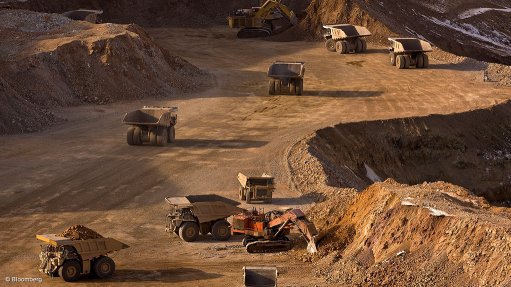
Photo by: Bloomberg
JOHANNESBURG (miningweekly.com) - As mining companies’ shareholder returns plunged over the past five years, productivity improvement – in new areas and ways – remained a focus for companies trying to boost value creation, a new report by Boston Consulting Group (BCG) has found.
The escalating costs and falling commodity prices, amid an uncertain economic environment, that have squeezed the margins of miners globally, have forced mining companies to take another look at enhancing productivity.
The ‘Value creation in mining: the productivity imperative’ report showed that, from 2002 to 2012, the 42 mining companies reviewed reported a weighted average yearly total shareholder return (TSR) of 16% – 8 percentage points higher than the S&P 500.
Speaking at a roundtable unpacking the results of the report, BCG mining and metals expert Jens Irion explained that, overall, mining created “tremendous” value during the ten-year period, but towards the end of the decade – from 2009 onwards – TSR fell flat.
“The sector created no value in this period. Not even the top ten were immune to the shocks … although they performed better than average.”
The TSR of the top ten mining companies reviewed fell from 38% to less than 15% in 2009.
The top ten mining companies comprised Grupo México, Inner Mongolia Yitai Coal, Industrias Peñoles, KGHM Polska Miedz, First Quantum Minerals, Exxaro Resources, Sociedad Química y Minera de Chile, Israel Chemicals, Antofagasta and Randgold Resources.
By the end of 2013, the combination of falling commodity prices, which was once an important contributor to TSR performance, and rising operating costs had caused the average yearly TSR of the more than 40 companies examined to plummet to –20%, placing the industry under “tremendous” pressure.
“2013 was a particularly bad year,” Irion commented, adding that gold mining companies were hardest hit, losing half their value and producing an average TSR of –51%, owing to the falling gold price.
However, declining commodity prices were not the only factor to weigh on the already “heightened pressure” on companies’ margins and cash flows by the end of 2013.
Ill-timed acquisitions added to some mining companies’ performance difficulties throughout the decade, particularly as merger and acquisition activity increased during the top of the commodity cycle when prices were at their highest.
But the failure of many acquisitions to create value subsequently resulted in major write-downs.
According to BCG’s report, a large proportion of the $60-billion in write-downs from 2012 through 2013 were related to acquired assets.
“The outperformers did not engage in high commodity buy-outs; they acquired bolt-on units,” Irion pointed out.
Operating and capital costs also spiked considerably over the decade, rising at a compound annual growth rate of about 11%.
Despite operating cost increases abating to 9% by 2012, commodity prices also started falling that year.
In addition to the increases in the unit cost of labour, consumables, services and fuel, besides others, weighing on margins and cash flow, deteriorating productivity also contributed to the downfall of the industry.
“It’s clear something needs to happen,” Irion said, noting that productivity improvements had a direct link to TSR growth.
Some mining companies have already undertaken efforts to reduce operating and capital costs, with several mining companies’ CEOs publicly outlining plans to boost efficiencies within their operations.
Achieving healthy returns and enabling long-term success required a steadfast focus on productivity; however, only 25% of transformation programmes succeeded in the long term.
“Successful operation transformation is hard,” he said, pointing to pitfalls such as a lack of strategic perspective, insufficient senior management buy-in and employee resistance preventing the transformation from getting off the ground.
Companies managing to start the step change faced loss of momentum, insufficient capabilities and tools and inadequate resources and budgets.
Further, change was not always sustainable owing to a lack of long-term vision and adaptability, inadequate handover to line management and unaddressed cross-functional inefficiencies.
The report noted that companies could miss opportunities to apply innovative technologies or new ways of thinking to operating an asset in the pursuit of incremental improvements.
“Incremental actions can yield only incremental results. Achieving a step change in performance calls for bold actions – thinking outside the box, rather than being constrained by past or current practices. Technology advances, changes in market conditions, other operations, and even practices within other industries spawn new ideas that can have a powerful impact on improving operations,” the report explained.
Further, the organisational structure, culture or management systems, all of which were critical to enable change, were ignored.
“Reducing headcount and deferring expenditures quickly reach their limit and a great deal of hidden value can be captured by using a systematic methodology that encompasses not only physical assets but also management systems,” the report concluded.